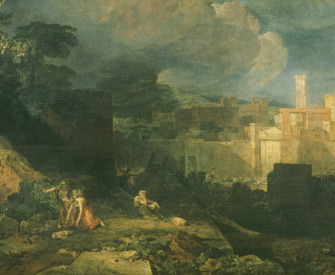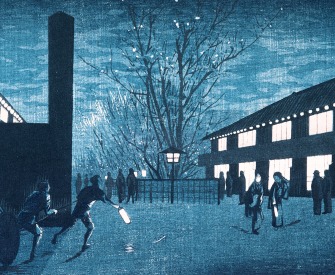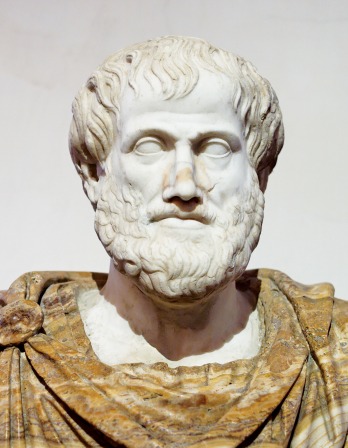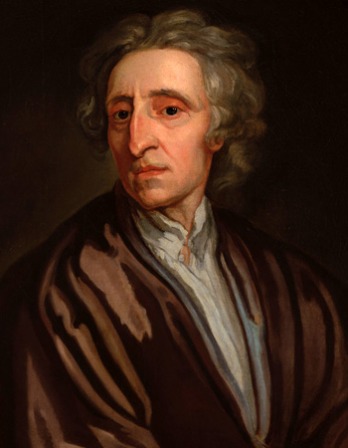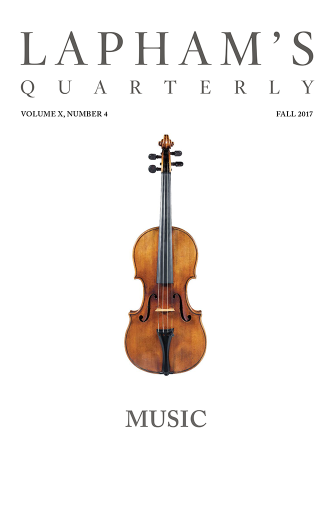I finished the Mickey Mouse and it came out beautiful, just the way I planned. Then I started work on another car with a desert scene. And Mono finished his piece, and then we all came together to start doing the rest. I was so tired. The first night, when we started doing it, I was energy packed. I was only drinking soda; Mono and Slave were drinking beer and stuff. But I was only drinking soda and eating crackers, and it was giving me energy, and I could have painted all night. Since I got chased that night, a lot of that energy went into my feet. And with all that worry, I lost a lot of energy, and I could piece, but I couldn’t piece as fast and as nice. So it was late when we got to the last two cars. And we said, “Let’s leave them.” But Mono said, “We’re doing ten cars. We came here for ten cars and we’re doing them. Fabulous Five!” So we did the Christmas cars. They were coming out nice but I was getting tired. And the thing is, they went inside and slept and left me out there by myself, piecing. Lazy bums, they were all high and I finished the two cars. But I finally finished, and then I knocked on the window and I said, “Yo, Mono, it’s finished.”
We got out of the lay-up at six o’clock in the morning. At seven o’clock the lay-up was gonna pull out. So I went home, didn’t sleep. Cleaned up just a little bit. Got my camera and went back to the station. At about seven o’clock I got there to Brooklyn Bridge, and guys are coming up to me and they’re shouting, “Oh man! Oh man!” And I said, “What’s the matter with you?” And they said, “Oh man, I’ve seen it!” And I said, “What have you seen?” And they said, “A whole train!” All the writers were there for early morning rush. And they said, “It’s bad style, Lee!” And I said, “Oh, shit, where is it?” And they said, “It went to the Bronx.” So I got on the next train and I said, “I’m going after it. I don’t want anybody with me.”
It was a cold day. It was two weeks before Christmas. And we were at Intervale on the Five and Two waiting for that train. There were two fine girls waiting at the train station. And then the train was coming. And I said, “Look at that train.” Like you could see barely on the side of it, all the colors flashing out toward the sun. The sun was right on them. And I said, “There it goes!” I got out my camera and it was coming closer and I said, “There it goes!” And it’s coming closer with the cars swinging. And I said, “It’s coming! It’s coming!” And the girls are saying, “What’s coming? What’s coming?” And I said, “Look,” and they said, “Oh my God!” And the first cars came in like a roaring horse and I said, “Look at it! Look at it!” And I was going so crazy I forgot to take pictures. And Devil, who was with me, said, “The pictures!” So I started taking pictures but I only grabbed like four cars. And then the train was pulling out, so then I jumped on. And I looked back at the girls, and they were just standing there with their mouths open. And it was like crazy. Like you could see the reflection in their eyes.
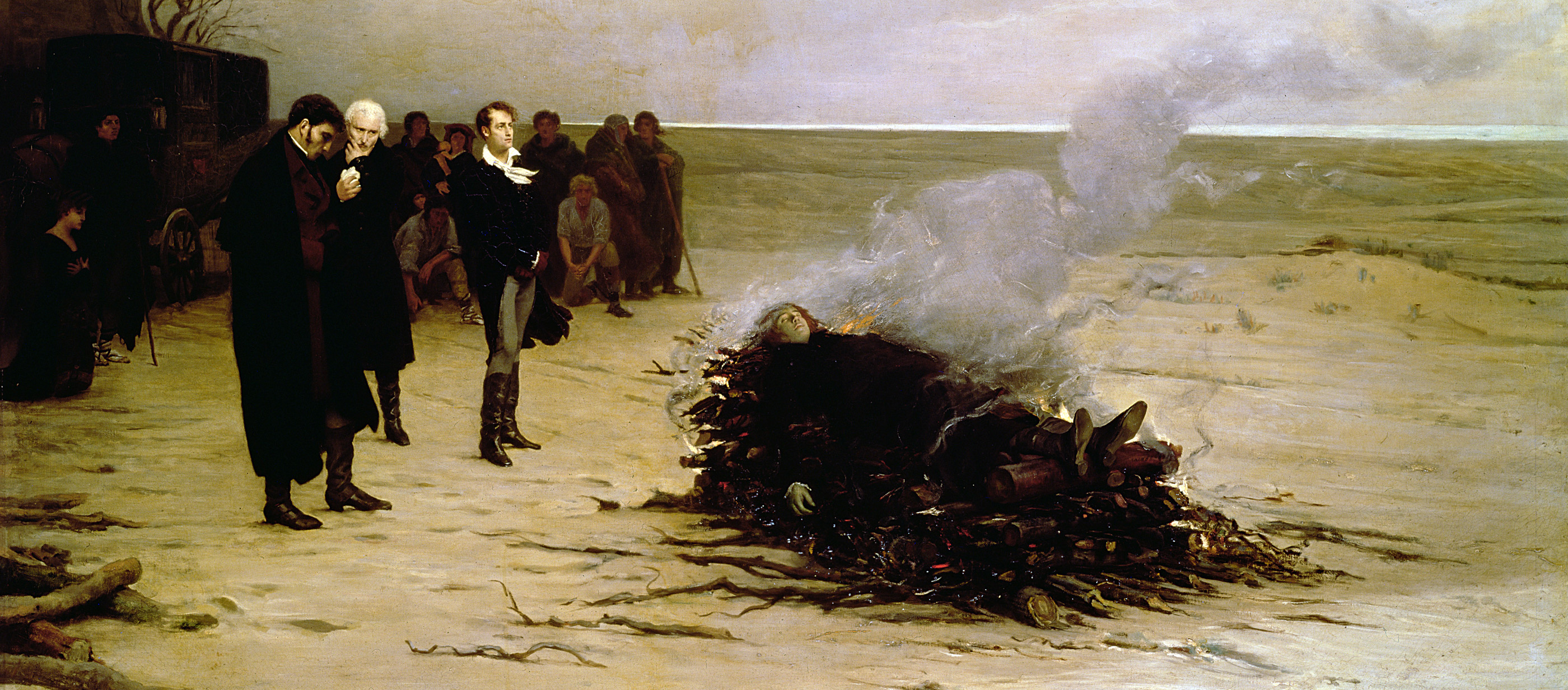
The Funeral of Shelley, by Louis-Edouard Fournier, 1889. Walker Art Gallery, Liverpool, England.
We decided to take the train to Baychester station and when the train stopped we’d pull the emergency cord to stop the train. That’s our specialty. So when the train pulled in, boom, we pulled it and I took some photographs. Then we got between the cars. It was by coincidence that a train pulled in on the other side that was jam packed, and it discharged all its passengers. They were taking it out of service. So that whole side of the station was packed, and I know that it was a shock to all these Wall Street Journals with their classy suits and suitcases. And they saw the whole train and everybody’s going like, “Oh, shit!” I’m looking out from between the cars and everybody’s going, “Look at that,” and I see all these hands pointing. Brooklyn Bridge is like lighted up for the first time. I was between the cars and people were looking at me but they didn’t know who I was, but I said, “How do you like it, people?” And young students and people like us are saying, “Yeah, it’s bad, all right!” It was beautiful, it was like a display and they were saying, “Oh, shit!” There was a whole bunch of people and there was a perfect crowd to see it, and as the train was leaving, we stuck our heads out and we’re shouting, “Yeah, Fabulous Five!” There were writers there and they said, “Look at them.” We took it to Forty-second Street. On the way there we were really hauling ass, and as we passed through the stations going fast the people were going, “Oh shit. Look at that” and pointing. At every station, it was a train stopper, a show stopper. At Fourteenth Street, people were yelling and cheering, but Forty-second Street was the biggest. Everybody was going, “Wow, look at that, man!” It was slowing down so they saw it car by car. I know that Mickey Mouse must have blown everybody’s mind. I started arguing with this black man. He didn’t like it; it was surprising. He was prejudiced or something. I said, “How do you like it? It’s a whole train.” And he said, “Aah, it’s disgusting.” So I said, “Fuck you, you mother. If you don’t like it it’s too bad, because it’s here right now.” At Fifty-ninth, the people saw it, at Eighty-sixth there wasn’t a big crowd, but at 125th, wow! It stopped right up to the platform so that you didn’t get a long view, you had to walk in right through the pieces. The station was packed and people were walking into the pieces with their eyes open, like “Wow, man.” It was nice to have it pull up right in front of you and then to get inside of it with the windows all painted. They probably didn’t know it was graffiti; they probably thought the city was doing something good for a change. They probably thought they paid some muralist to do it.
When we went into the slums in the Bronx, the train was elevated so people could see the whole train. You could see people blocks away going, “Look at that!” I’m serious. I notice people, I watch people on the street. People only look up once in a while. They look down mostly. But this time, you’d see people looking up and they’d really look. Little kids were going, “Mickey Mouse. Look Mommy!” People were going crazy. There’s a park at Simon Street where it makes a turn and there’s a big avenue there, Westchester Avenue. People were all crowded up there in front of the stores, and they were looking up and going “Wow!” You could see the reflection in the windows of the slums of the cars all painted. Every car was like a TV, and you could see the colors reflected. And then we got to Baychester. The train was swinging from side to side. We were hanging out the sides and the windows going, “Yaah! Fabulous Five!” I was on the side of the train, I’d actually climbed out a little on the side, and before the train stopped I jumped out onto the rocks and got to the other side, no matter what, cops or not, and took pictures. And then I heard the train go “whoosh,” and it stopped and I knew they pulled the emergency. And then I heard the conductor going, “Who the hell pulled that?” Then I saw all the Fab Five jumping out of the train shouting, “Yaah, take pictures!” And everybody’s there with their thirty-fives, clicking. It was a nice sunny day. And when the train left, we said, “Yeah, all right. Job well done!” There was only one guy in that station, and he was looking at us. And I said, “How do you think about it?” And he said, “Incredible, man, incredible!” We didn’t wait for it to come back. We decided to take the next train home.
It didn’t run again. The next day I went to Brooklyn Bridge and I thought, “This thing has to be together. At least five cars.” But they were all broken up. One train came in with Mickey Mouse, another came in with a Mono car, and I said, “Wow, split up already, oh my God!” Every piece was on different lines, different trains. It was crazy. But that had been the greatest moment of the Fab Five ever. And that I ever had.
© 1982 by MIT Press. Used with permission of MIT Press.
From an interview. Along with Keith Haring and Jean-Michel Basquiat, Quinones was one of the leading figures of the New York City street-art movement. He painted his first subway piece in 1974 and was asked to join the Fabulous Five, an elite graffiti squad, in 1975. Their top-to-bottom and end-to-end painting of the ten-car train is considered their finest accomplishment.
Back to Issue


